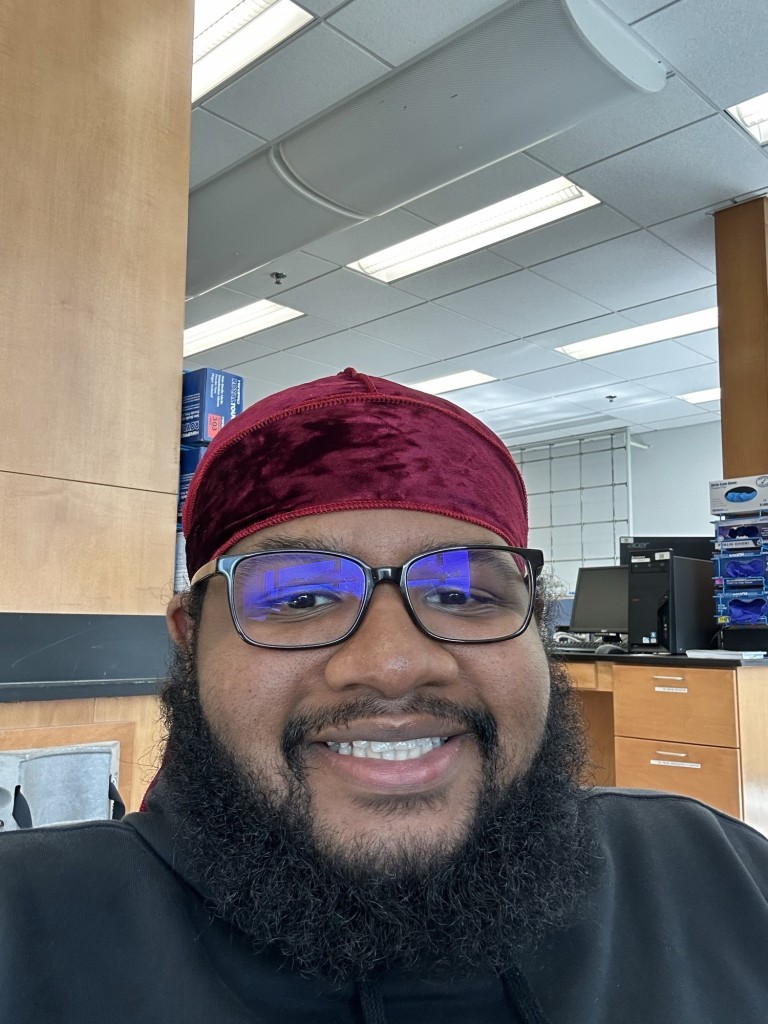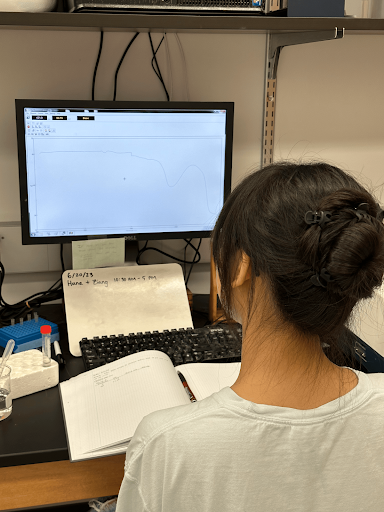What’s up guys!! It’s your group, the NanoLab from the Chemistry Department, back with another X-SIG blog post! We got a couple of old and new faces to show you along with four projects going on in the lab this summer. Before you continue reading, be sure to SMASH that like button down below AND hit the subscribe button to stay updated with what’s going on in the lab (to actually stay updated with the lab, you can visit our lab website: nanolab – @ Gettysburg College). Also, comment down below what your favorite element is!! Now without further ado… let’s get into it.
From left to right: Khristian Banks, Cole Springer, Dr. Thompson, Yesenia Posada Cruz, and Hana Konno.
Meet the Lab Members
Dr. Thompson: I’m supposedly in charge of the NanoLab but often I feel like I have no idea what I’m doing. I guess that’s part of doing research, right? I’m lucky to have four wonderful students working with me this summer and you’ll get to hear a little about their work below.
Cole Springer: Hi everyone, I’m Cole! I’m a rising senior and a chemistry and German studies major. This is my first summer in the NanoLab, but I’ve worked the past two summers with Dr. Funk on some organic synthesis, which I’ve gotten the chance to do this summer as well! My favorite element is Osmium because of its status as the densest element! I have a couple grams of it, and I find density to be a weirdly fascinating property of elements.
Hana Konno: Hi guys! My name is Hana, and I’m a rising junior and a chemistry major. This is my second summer in the NanoLab, and I am continuing on with the project that I have been working on since last summer. My favorite element is Einsteinium because the name sounds really cool.
Yesenia Posada Cruz: What’s up everyone! My name is Yesenia, and I’m a rising senior chemistry major, math minor. This is my first summer in the NanoLab, but I have been working in the lab since last semester. My favorite elements are Yttrium and Xenon because they have very unique spellings!
Khristian Banks: Hi everyone! My name is Khristian, and I am a rising sophomore majoring in chemistry and minoring in German Studies. This is my first summer in the NanoLab, and I’m working on an aquatic toxicology project in tadpoles at different temperatures. My favorite elements are chlorine and platinum!
The NanoLab Projects
Project 1 (Hana): Polymer Functionalized Self-Assembly of Gold Nanorods using pH Modifications
Alright, so the basic rundown of my project is that I am synthesizing gold nanorods, then adding two different layers of chemicals called polymers onto the nanorods, and then raising the pH of the nanorod solution to get the nanorods to assemble. Gold nanorods look exactly what they sound like (very small rod-shaped pieces of gold). The image to the right is what a single nanorod looks like! What is special about the outer layer polymer (called Poly-l-lysine) that I coat onto my nanorods is that when the pH is near 10.5 (to match the pKa of the polymer), the polymer changes its structure, which is what drives the nanorod assembly. Gold nanorod assembly is important because it has a wide variety of applications including drug delivery, cancer therapy, etc. I am using a couple of different instruments to collect characterization data for my project, but the coolest instrument that I am going to mention is the Transmission Electron Microscope (aka the TEM). It is a very fancy microscope down in the Imaging Suite of the Science Center. Below is one of the images I took using the TEM! If everything goes well this summer, then my project will be published in a journal sometime in the near future!
Project 2 (Cole): Tuning the Adsorption of Polyelectrolytes to Gold Nanospheres
My project is heavily based on the question, “what happens if…?” From past work in the lab, we have been able to “coat” our gold nanospheres with polyelectrolytes (charged polymers) and quantify how much of the polymer adsorbs to each individual nanosphere (which are usually between 1-50 nm in diameter). This student’s work (Celina Harris) was actually published in a scientific journal! However, one question that arose from her work in the NanoLab was how to tune the amount of polyelectrolyte that adsorbs to our nanospheres. This is where my work starts.
Part of my project has been to synthesize a new intermediate layer (which we use to prevent the aggregation of nanospheres and control their size) that will allow us to quantify both how much of the intermediate layer and the polyelectrolyte coating is on the surface of the gold nanosphere. This would grant us insight into the electrostatic interactions that take place at the surfaces of gold nanospheres and how we can harness those interactions to controllably add molecules to our nanospheres. This work is especially useful when considering that gold nanoparticles show promise as drug delivery systems, and of course, the amount of drug delivered is quite important!
My summer started out by simply synthesizing gold nanospheres (which is a really finicky process), and then moved on to trying to polymerize the intermediary layer. We thought that we could reliably quantify the amount of these molecules on the gold surface due to the relative lack of exchange with free molecules in solution compared to a different intermediary layer, where the molecules freely adsorb and desorb from the gold surface.
A depiction of our free molecule versus the polymerizable version.
However, none of my attempts at polymerizing this molecule worked, and so I moved onto synthesizing a new molecule, which will strongly adsorb to the gold surface and allow us to quantify how much is adsorbed without worrying about a fluctuation in the amount of molecules adsorbed.
The molecule I’m synthesizing.
I am just starting to wrap up this synthesis, so I will start using this molecule with our gold nanospheres and accomplish my goal of quantifying not just the polyelectrolyte coating, but also the intermediary layer. I’m hopeful this will lead to cascading effects of learning how to tune the amount of polyelectrolyte that binds to our gold nanospheres, and lead to more discoveries along the way!
Project 3 (Yesenia): Exploration of Gold Nanoparticles and BSA Interactions Through Surface Chemistry
My project is interested in exploring how gold nanoparticles with known surface chemistries interact with a model protein called bovine serum albumin (BSA). Some examples of the surface chemistries I have worked with this summer are positive, positive-neutral mix, neutral, neutral-negative mix, and negative. For most of my experiments, I am pipetting solutions of nanoparticles (with the examples of known surface chemistry) with solutions of BSA then analyzing them using different instruments. It is very important that in my experiments my spheres do not aggregate. So, to characterize and make sure this has not happened, I use ultraviolet visible spectroscopy to determine the state of my particles. Additionally, I use circular dichroism spectroscopy to determine the secondary structure of the BSA on the particles, such as α-helix or β-sheet as a function of nanoparticle surface chemistry. Knowing and bettering our understanding of how the surface charge of gold nanoparticles can influence the way proteins bind is important in applications such as drug delivery and photothermal therapy. I look forward to continuing to work with the surface chemistry of gold nanoparticles and seeing what biological interactions can be discovered!
Project 4 (Khristian): Analysis of Citrate-Capped Gold Nanoparticle Uptake During Tadpole Metamorphosis at Varying Temperatures
The purpose of my project is to learn more about how gold nanoparticles impact the metamorphosis of tadpoles at different temperatures. Gold nanoparticles are used in a variety of consumer products from clothing and cosmetics to paints. Due to their versatility, gold nanoparticles will inevitably end up in waterways due to dumping and other ways of pollution. Through my project, we are hoping to learn more about how gold nanoparticles, at relatively low concentrations, may impact the growth of aquatic animals. As global warming becomes more of a pertinent issue, it is also valuable to learn about how that may play a role in the growth of the same tadpoles, so I am working with tadpoles that had been exposed to gold nanoparticles at 3 different temperatures: 15, 20, and 25 °C.
Figure 1: Tadpole School Picture.
The procedure for my project includes obtaining the tadpoles from Dr. Fong’s lab where they have been well taken care of for several months. I weigh each tadpole and dissolve them in concentrated nitric acid in their respective vials. I then use a hot plate to evaporate the acid overnight. After letting the vials cool, I resuspend them in 10% aqua regia, which is made of HCl and HNO3. Yay, strong acids and bases! I then use the Sonicator named Hedgehog (which has a mustache!) to get all of the solid floating off the sides of the vials and into solution. Lastly, I filter each solution into a conical tube until it is time to use the ICP-OES. During this time, I also make calibration curves, which are useful for finding how much gold was in each sample. Once I find out how much gold was in each sample, I do a few calculations to find the micrograms of gold per gram of frog. At the time of writing this, it looks to me that the tadpoles at 25°C uptake the most gold, but I still have dozens more tadpoles to process. Another interesting note is that many of the tadpoles at 15°C have not reached metamorphosis yet, so they are being exposed to the nanoparticles for an extended period compared to the other temperature groups. This situation could potentially mean that the tadpoles at the lowest temperature will uptake the most gold, so it will be interesting to see what happens!
One extremely important part of my project is keeping everything clean and reducing the risk of contamination. Since the NanoLab has been working with gold for several years, it is likely that some of the tools and glassware have been exposed to gold. In order to reduce the risk of contamination in the tadpole samples, I have a long cleaning procedure for each vial and other glassware I use.
Lab Shenanigans:
Some of us on the DC Trip featuring the Smithsonian elephant, molecules, and a gold exhibit (to stay on theme of course).

















